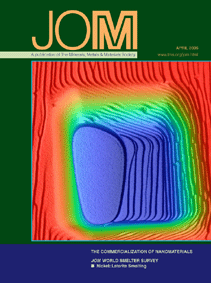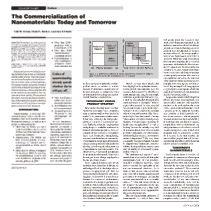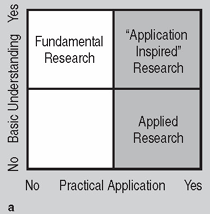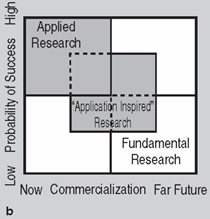 LATEST ISSUE |
||||
TMS QUICK LINKS: |
• TECHNICAL QUESTIONS • NEWS ROOM • ABOUT TMS • SITE MAP • CONTACT US |
JOM QUICK LINKS: |
• COVER GALLERY • CLASSIFIED ADS • SUBJECT INDEXES • AUTHORS KIT • ADVERTISE |
|
| Industrial Insight: Feature | Vol. 58, No.4, pp. 21-24 |
The Commercialization of
Nanomaterials: Today and Tomorrow
Todd M. Osman, Daniel E. Rardon, Lawrence B. Friedman, and Luis Fanor Vega
| ||||
| ||||
| ||||
|
| ||||
Author’s Note: The material in this paper is intended for general
information only. Any use of this material in relation to any
specific application should be based on independent examination
and verifi cation of its unrestricted availability for such use, and a
determination of suitability for the application by professionally
qualified personnel. No license under any patents or other
proprietary interest of any party is implied by the publication of
this paper. Those making use of or relying upon any information
furnished in this paper assume all risks and liability arising from
such use or reliance, and no warranty of any kind is given with
respect thereto, including, without limitation, any express or
implied warranties of merchantability or fitness for an intended
purpose.
Questions? Contact jom@tms.org. © 2006 The Minerals, Metals & Materials Society |
|
INTRODUCTION Nanotechnology is receiving substantial attention in the technical communities as well as in the public at large. Momentum continues to build in both arenas, as demonstrated by:
As such, nanomaterials are often in the forefront of discussions within the materials community today. Furthermore, academic institutions, government laboratories, and industrial facilities are expending significant resources in the pursuit of nanomaterial technologies. While there may be many criteria with which to critique the success of these efforts, a potent litmus test will be the number of new products that are successfully introduced into the marketplace. To this point, critics of nanotechnology are already questioning whether the investment will pay off. A recent publication2 cites that the global investment in nanotechnology over the past eight years is equivalent in absolute dollars to the entire NASA Apollo program; however, “eight years into Apollo, the program had already achieved the first manned flight around the moon, while the entire output of the nanotech(nology) program in the layman’s view still consists of only stain-resistant pants.” While nanomaterials, and nanotechnologies as a whole, may be important enablers for new products, commercial production of nanomaterials and nano-enabled materials is not new. The development and application of structure-property relationships has long been the basis for product developments. There are many examples of “traditional” nanomaterials, including high-strength low-alloy steels developed with nanosized niobium carbides for toughness-critical applications, age-hardenable aluminum alloys that utilize nano-sized Guinier-Preston zones for strengthening, heat load reduction glass products employing nano-thin films of metals and metal oxides, and paints containing various nanoparticles for color, rheology, and enhanced properties. It should be noted that these applications were made commercially successful not necessarily by reducing their size down to the nanoscale, but rather by growing to the final nano-scale structure from their respective constitutive natural (i.e., atomic) form to achieve the optimum dimension for property enhancement. The utilization of nanosized structural features is an important approach for new product design; however, it is not the only technique available to today’s materials engineers. Utilizing nanomaterial technologies just to produce a nanomaterial is oftentimes illogical. Programs that involve nanomaterials should be judged on the same basis as conventional product developments: whether the resultant product meets or creates a market demand. Furthermore, manufacture of the product must be compatible with environmental stewardship and meet or exceed financial considerations. TECHNOLOGY VERSUS PRODUCT STRATEGY Increasingly, however, nanomaterials are being investigated in the laboratory and being utilized in the design of new products, ranging from golf balls to flame-retardant polymers to self-cleaning glass. A driver for this trend is the demand for improved performance, whether it is for strength, appearance, or durability. Additionally, modern process controls, manufacturing techniques, and analytical capability advances have provided enabling technologies for the production and incorporation of nanosized features in the final product. There have been many articles that have highlighted the potential commercial impact of nanomaterials (see, for example, References 5–9). The effect of nanomaterials may range from a simple evolution in product performance (e.g., a shift in strength-ductility-toughness combinations) to a “disruptive” technological advancement. It is the potential for a revolutionary step in product performance that has caught the attention of researchers and investors alike. Nanotechnologies have been cited as having “the potential to impact virtually every industry, from aerospace and energy to health care and agriculture”1 as well as holding “promise for virtually every field of human endeavor, from slice-resistant golf balls and chameleon-color surface finishes to highly sensitive, non-invasive medical diagnostics.”10 By now, there is arguably enough technical evidence to support these statements; however, whether these predictions come to pass may ultimately be determined by nontechnical factors. The environmental impact of nanomaterials must be considered during the development cycle. All new products, including traditional materials, must meet or exceed the applicable safety and environmental standards. As a result of their unique nature, efforts are underway within industry, academia, and government to investigate and catalog various nanomaterials in a systematic fashion.11–13 Past and current efforts in this area provide guidance for the safe use of nanomaterials on a large scale and must continue to be supported by the materials community. The cost of production and/or use of nanomaterials is a critical factor that will greatly affect the success of new product developments, especially in the higher-volume materials sectors. A large proportion of nanotechnology-oriented research and development is focused on more advanced, niche-type applications where high margin potentials are predicted. While this work is important, developments requiring the least capital investment with minimal effect on production speeds are the most attractive to industry. As such, industrial developments need to be scrutinized with respect to anticipated production infrastructure and capabilities as well as the total cost to the customer. In the steel industry, for example, novel coatings are most attractive if they are capable of being applied at typical process line speeds, which can range from 62 meters per minute to more than 370 meters per minute. Large-scale commercial development efforts involving nanomaterials and nano-enabled materials will therefore continue to be evaluated on the same terms as more traditional materials. Such a process at many industrial facilities may consider an initial portfolio of a few dozen or more candidate projects; however, after evaluating the probability of technical and commercial success, compatibility with environmental and safety standards, and the effect on overall manufacturing costs, only a handful of programs may be pursued in earnest. As discussed in the next section, the nano-enabled projects that will be commercialized most often will be those that address a clearly identified need. TOMORROW’S NANOMATERIALS Looking to the future, it is estimated that greater than ten percent of aerospace products will contain emerging nanotechnologies by 2009, followed shortly thereafter by the same market share in automotive products.14 These market projections, however, assume not only an increase in the production of current products, but also cost-effective commercialization of new nano-enhanced materials. Undoubtedly, there will be many opportunities for homogeneous nanomaterials (i.e., structures in which the entire cross section can be classified as a nanomaterial) as well as integrated structures in which the nanomaterial comprises only a portion of the final product (e.g., coatings or films applied to a metallic substrate). There are many efforts currently underway to develop the next generation of nano-enabled materials, as evident by the resources being expended in this area. The focus of individual projects being conducted as part of this enterprise varies greatly across material systems as well as intended market segments. Most likely, the ability to commercialize products arising from these programs will be linked to the primary focus of the laboratory- or pilot-scale studies. As shown in Figure 1, there are three broad categories for research and development efforts: applied research, applications-inspired research, and fundamental research. Applied research employs known fundamentals to produce new products. As the basis for this work is well established, the likelihood for success is relatively high and development work typically can be readily transferred to industrial practice. In contrast, applications-inspired research may require the investigator to conduct basic research to facilitate production. Current examples of this type of work can be found in energy programs such as reversible ambient temperature hydrogen storage and next generation transmission lines, which may require the development of new theories and models for energy nanoscience.16 Finally, fundamental research is focused primarily on mechanistic understanding aimed at increasing scientific knowledge. Commercial applications may arise from this type of work, but the probability is relatively low and would most likely occur well in the future. The knowledge gained through these programs, however, may very well form the basis for future applications-inspired researchers. Today’s commercially driven activities are primarily a mixture of applied and applications-inspired research. There will continue to be a role for traditional nanomaterials in new products, whether they are new applications of existing pigments in coatings or the refinement of practices for the stabilization of nanosized phases in metals and metallic alloys. These evolutionary developments are important, but the development of new designs and techniques for functional nanomaterials will most likely be needed to fulfill the market projections discussed earlier. There are many opportunities for applied and applications- inspired research that can result in paradigm shifts for product performance. While not an exhaustive compilation, the following items highlight fruitful areas for development programs that address current commercial needs:
CONCLUSION Both the technical community and the popular press continue to focus upon nanotechnologies. Many predictions exist for the role of nanomaterials in future products and there are numerous activities throughout the world dedicated to the development of nanomaterials and nano-enabled materials. While there may be many criteria with which to quantify the success of these efforts, the ultimate measure will be the number of new products that are successfully introduced into the marketplace. To that end, there will most likely be increased pressure in the future to document benefits accrued from the current level of global investments in nanotechnology. While the potential for the next generation of nanomaterials and nano-enabled materials remains great, it is recommended to focus on research and development efforts designed to address identified commercial needs in order to achieve the projections for large-scale market impact. As such, there will be a need for more collaborative efforts in the future between industry, academia, and government to work on technologies of common interest. Such a model is being pursued by the Pennsylvania Nano-Materials Commercialization Center, which brings together a cooperative of companies, including Alcoa, Bayer MaterialScience, PPG Industries, and United States Steel Corporation as well as Carnegie Mellon University, the University of Pittsburgh, and Pennsylvania State University. The primary mission of the Pennsylvania NanoMaterials Commercialization Center is to develop and commercialize innovative solutions to meet the current and future needs of the marketplace, including organic and inorganic nanomaterials, coatings, sensors, and film applications. ACKNOWLEDGEMENTS The authors would like to acknowledge the Pittsburgh Technology Council, the Commonwealth of Pennsylvania, U.S. Congressman Mike Doyle, and the Heinz Foundation for their support of the Pennsylvania NanoMaterials Commercialization Center. The vision of Dr. David Diehl of PPG in bringing the founding participants together is also appreciated. REFERENCES 1. The National Nanotechnology Initiative at Five Years: Assessment and Recommendations of the National Nanotechnology Advisory Panel, President’s Council of Advisors on Science and Technology (May 2005), www.ostp.gov and www.nano.gov.2. “Where Has My Money Gone? Government Nanotechnology Funding and the $18 Billion Pair of Pants,” Cientifica (January 2006), www.cientifica.com. 3. J.H. Marburger, “Nanotechnology: Government’s Role,” presented at MS&T ‘05, Pittsburgh, PA, 26 September, 2005. 4. The Nanotech Report 2004, Lux Research (www.globalsalespartners.com/lux/). 5. S. Baker and A. Aston, “The Business of Nanotech,” Business Week (14 February, 2005), pp. 64–71. 6. A.M. Thayer, “Nanomaterials,” Chemical and Engineering News, 81 (35) (2003), pp. 15–22. 7. Nanomaterials to 2008—Market Size, Market Share, Demand Forecast, and Sales, Fredonia Group (2005), www.freedoniagroup.com/nanomaterials.html. 8. J.G. Reynolds and B.R. Hart, “Nanomaterials and Their Application to Defense and Homeland Security,” JOM, 56 (1) (2004), pp. 36–39. 9 T. Imerito, “Nanotechnology: Building from the Bottom and Building the Bottom Line,” JOM, 57 (12) (2005), pp. 18–23. 10. T. Imerito, “Nano-Nano,” Pittsburgh TEQ (September 2005), pp. 14–18. 11. R.F. Service, “Calls Rise for More Research on Toxicology of Nanomaterials,” Science, 310 (12) (2005), p. 1609. 12. “NIOSH Announces Forthcoming Library for Nanomaterial Information, Contacts,” Patent, Trademark and Copyright Journal, 70 (1740), pp. 667–668. 13. Nanotechnology White Paper, Science Policy Council, U.S. Environmental Protection Agency (www.epa.gov/osa/nanotech.htm). 14. Sizing Nanotechnology’s Value Chain, Lux Research (2004), www.globalsalespartners.com/lux. 15. D.E. Stokes, Pasteur’s Quadrant: Basic Science and Technological Innovation, (Washington, D.C.: Brookings Institution Press, 1997). 16. Nanoscience Research for Energy Needs, Report of the National Nanotechnology Initiative Grand Challenge Workshop, 16–18 March, 2004, www.science.doe.gov/bes. 17. S. Vaynman, et al., “Recent Advances in High-Strength, Low-Carbon, Precipitation-Strengthened Ferritic Steels,” Proceedings of MS&T ’04 (Warrendale, PA: AIST, 2004), pp. 525–530. 18. D.J. Branagan, et al., “Wear-Resistant Amorphous and Nanocomposite Steel Coatings,” Metall. and Mater. Trans. A, 32A (2001), pp. 2615–2621. 19. T. Laha, et al., “Forming Nanostructured Hypereutectic Aluminum via High-Velocity Oxyfuel Spray Deposition,” JOM, 56 (1), pp. 54–56. 20. A.M. Thayer, “Nanomaterials,” Chemical & Engineering News (1 September 2003), pp. 15–22. 21. K. Bukholz, “Improved Mar Resistance with Nano Particle Technology,” AEI (February 2005), p. 56. 22. D. Rardon, “Nanotechnology at PPG: From Potential to Products,” Advanced Materials and Processes, (December 2005), pp. 27–28. 23. R. Fernando, “Nanomaterial Technology Applications in Coatings,” JCT Coatings Tech (May 2004), pp. 32–38. 24. R. Stewart, “Nanocomposites,” Plastics Engineering, (May 2004), p. 23. 25. F. Cosandey, G. Skandan, and A. Singhal, “Materials and Processing Issues in Nanostructured Semiconductor Gas Sensors,” JOM-e, 52 (10) (2000), www.tms.org/pubs/journals/JOM/0010/Cosandey/Cosandey-0010.html. 26. P.M. Dehmer, “Some Energy Facts and Their Implications for R&D Needed to Secure an Energy Future,” presented at MS&T 2005, Pittsburgh, PA, 26 September, 2005, www.science.doe.gov/bes. 27. M. Kryder, “Giant Magneto-Resistance and Its Impact Upon Data Storage,” presentation to the Congressional Caucus on Research and Development, Washington, D.C., 12 May, 2005. 28. R. Hempstead, “Nanotechnology at Seagate,” presented at MS&T 2005, Pittsburgh, PA, 26 September, 2005. 29. “Pushing the Boundaries of Data Storage in the Information Age,” www.seagate.com/newsinfo/newsroom/papers. Todd M. Osman is a Technical Manager with the United States Steel Corporation; Daniel E. Rardon is a senior scientist and Manager of Nanotechnology Initiatives at PPG Industries; Lawrence B. Friedman is Head of University Relations at Bayer MaterialScience; and Luis Fanor Vega is Manager of Engineered Finishes for Alcoa. For more information, contact Todd Osman, United States Steel Corporation, 800 East Waterfront Drive, Munhall, PA 15120; (412) 433-7280; fax (412) 433-7232; e-mail tosman@uss.com. |




